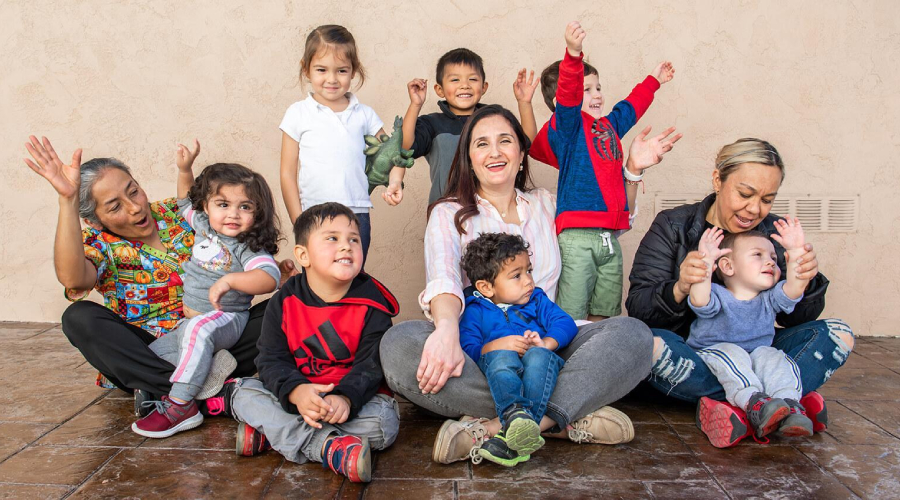What’s in this article
For Miren Algorri, some good things are worth the wait — even if it takes two generations.
Miren has worked in child care for 23 years. She’s a family child care provider, running her center out of her own home in Chula Vista, California. She takes care of 11 children, with the help of her assistant, who’s been with her throughout those twenty-some years.
And all that time, Miren has been one of the more prominent voices in the push to organize California’s family child care workers into a union, called Child Care Providers United.
“My mom ran a child care center too, and she was one of the first people in the union movement in San Diego. I remember her coming back from these meetings feeling so empowered, so happy to support her colleagues and their communities,” she says. “This whole movement boils down to a lack of equity in child care.”
The coronavirus is showing the world just how crucial child care is, while simultaneously pushing the sector to its breaking point. And while the sector awaits more government support, California’s family child care providers have taken this moment to formally organize as CCPU.
Now, the sector has a stronger voice to fight for change that lasts long beyond the coronavirus.

It’s not just that child care is essential now — it’s always been essential. The coronavirus just forced everyone else to pay attention.
“The pandemic has been devastating for us, because child care providers are on the front line. We’re risking our own health because we care about children, about our colleagues, and about the community. And if we’re not available, parents can’t go to work. It’s as simple as that,” Miren says.
The coronavirus only exacerbated all the pressures that child care workers were already dealing with. Some of Miren’s families were forced to withdraw their children from her care, and many of her colleagues are facing the threat of COVID-19 with no health insurance. At the start, she even had trouble even getting enough hand sanitizer for the 11 children at her center.
“They say that we’re essential, yet we’re not treated like we’re essential,” She says. “We’ve been supported, but that doesn’t mean things have been peachy. It’s been stressful, frightening, and overwhelming.”
With more national attention focused on child care than ever before, Child Care Providers United represents a way for workers to come together, emphasize the importance of protecting the sector, and provide even better care to their communities.
Child Care Providers United officially came into being at the end of July, in an election that saw 97 percent of votes cast in favor of its creation.
The vote became a legal possibility through the Building a Better Early Care and Education System Act, which gave child care providers the right to organize and collectively bargain with the state. In the movement’s 17-year history, previous attempts to pass this legislation were repeatedly vetoed by Governors Arnold Schwarzenegger and Jerry Brown.
CCPU represents California’s approximately 43,000 family child care providers, whose centers account for about 28 percent of licensed child care spots in the state. These workers now have the voice to negotiate for better working conditions — more funding, more training, and more benefits like time off and health insurance.
For Miren, this just makes sense. When educators and child care workers have their basic needs covered, they can give better care to children.
“Right now, the system is broken, but the reason you can still get quality care is because providers are so passionate about what we do. Still, we’re only human, and we have to cover human expenses. Not a lot of educators can do that in these current conditions,” she says.

As we’ve talked about before, it’s uniquely difficult for child care providers to organize, because the sector is so diverse. But the emergence of CCPU serves as an example of how smaller coalitions can get together to fight for big changes.
“It’s about having the strength in numbers to not let anyone bully us. Because at the end of the day, they’ll bully us if we let them,” Miren says.
According to Education Workers United, family child care providers have successfully formed unions in 16 states across the US. Here are some of the benefits these unions have successfully negotiated for child care providers:
In a state with the second-highest cost of living in the country, some licensed family child care providers earn as little as $5 per hour. The majority of California’s home-based providers are women of color, and 58 percent rely on government assistance to support their own families.
CCPU, then, gives a stronger voice and influence to some of the state’s most marginalized, underpaid and overlooked workers.
As Miren explains, improving the working conditions for the sector isn’t just about bettering the lives of the workers themselves. It’s a ripple effect, where improving the working lives of educators and caretakers extends deep into the community they serve. Child care is the glue that keeps communities together. It allows parents to make it to work, eases stress off families, and helps children get their best start in life.
But she’s careful to note that there’s still a long way to go.
“We’ve been working for 17 years to get this together, and that was just the first step. Now that we’ve got this formal union together, we can start focusing on the change we want to see. So the real fight has only just started,” she says.

If you’re feeling like the child care sector needs support, you’re certainly not alone. Miren says that making that change starts with little steps.
“Reach out to other providers. That’s where your strength lays — it’s one provider at a time,” she says.
Starting these networks and collecting these voices could be anything from a Facebook group to a WhatsApp group message. This is where it starts — forming local communities allow providers to identify the issues they’re all struggling with, and decide on a plan of action to pursue together.
When we look around the world at how child care workers have won positive changes, we see a common thread: Local networks and union-led advocacy movements. Earlier this year, Ireland saw tens of thousands of child care workers gather for union-led protests demanding more investment in the sector. In turn, the new Irish government has made child care support a major priority, particularly within the national coronavirus response.
Another thing you can do is join mailing lists to stay informed on the news and policy that’s most relevant to child care workers. Child Care Relief, Moms Rising, and Parents Together are all great options to get started.
In organizing these networks, another strength Miren points to is parents — keeping them in the loop is a big part of gathering momentum.
“Ultimately, we’re fighting on behalf of the children in our care,” Miren says. “When parents see that, this becomes their fight too. We’re pulling for this together, because we all want what’s best for children.”
Please note: here at Famly we love sharing creative activities for you to try with the children at your setting, but you know them best. Take the time to consider adaptions you might need to make so these activities are accessible and developmentally appropriate for the children you work with. Just as you ordinarily would, conduct risk assessments for your children and your setting before undertaking new activities, and ensure you and your staff are following your own health and safety guidelines.